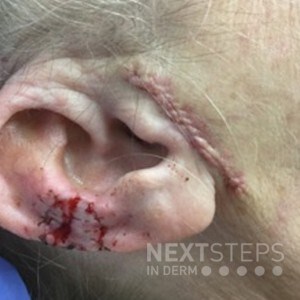
The correct answer is B. Full-thickness skin graft.
This is an example of a full thickness skin graft. There is a circular graft on the ear, and a linear scar on the preauricular cheek indicating this as the donor site. Donor sites are commonly taken from the pre or post-auricular skin as it is easy to hide the scar in those locations.
A split thickness graft is composed of epidermis and some dermis and is very thin. The donor site is usually left to heal by secondary intent and taken from a site that is easy to conceal, therefore there would not be a linear scar on the preauricular cheek. A composite graft typically includes 2 tissue types such as cartilage and skin. Although composite grafts can be use to repair ears to rebuild the structure/foundation, it would require cartilage to be taken from a donor site on the nose or ear, and the photo does not show any donor sites that would indicate this. In addition a very small defect, such as the one shown in this image, would likely not require cartilage. An interpolation or transposition flap would not have a linear scar at the preauricular cheek.
